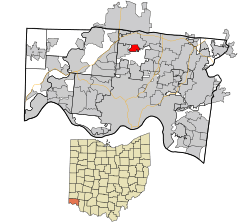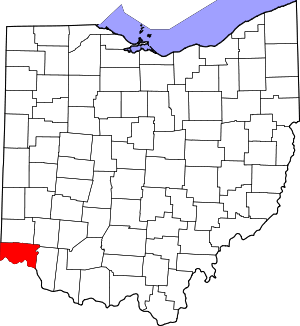Greenhills, Ohio
Greenhills is a village in Hamilton County, Ohio, United States. The population was 3,615 at the 2010 census.[7] A planned community, it was established by the United States government during the Great Depression. Most of the village is a National Historic Landmark for its history as a planned modernist community.[8]
Greenhills, Ohio | |
|---|---|
Greenhills Ohio Municipal Building | |
| Motto(s): "Pioneering a Dream" | |
 Location in Hamilton County and the state of Ohio. | |
| Coordinates: 39°16′7″N 84°31′2″W | |
| Country | United States |
| State | Ohio |
| County | Hamilton |
| Government | |
| • Mayor | David Moore (R)[1] |
| Area | |
| • Total | 1.24 sq mi (3.22 km2) |
| • Land | 1.24 sq mi (3.22 km2) |
| • Water | 0.00 sq mi (0.00 km2) |
| Elevation | 804 ft (245 m) |
| Population | |
| • Total | 3,615 |
| • Estimate (2019)[5] | 3,567 |
| • Density | 2,867.36/sq mi (1,106.88/km2) |
| Time zone | UTC-5 (Eastern (EST)) |
| • Summer (DST) | UTC-4 (EDT) |
| ZIP code | 45218 |
| Area code(s) | 513 |
| FIPS code | 39-32158[6] |
| GNIS feature ID | 1064757[3] |
| Website | www |
History and significance
As one of three "Greenbelt Communities" built by the short-lived Resettlement Administration during the 1930s (the other two are Greenbelt, Maryland and Greendale, Wisconsin[9][10][11]), Greenhills was designed to be surrounded by a "belt" of woodland and natural landscaping. Like the other six "FDR towns", Greenhills was founded as a sundown town, using restrictive covenants to prevent minorities from purchasing homes there.[12][13] Many families include third- and fourth-generation descendants of the village's original "pioneers" who occupied the original International-style townhomes. The original government-built area, the Greenhills Historic District, is listed on the National Register of Historic Places[14] and is a National Historic Landmark.[15] The community's James Whallon House, which serves as the village hall is also listed in the National Register of Historic Places.[16][17] The landmarked area encompasses about three quarters of the area within the village bounds, excepting only the northeastern section northeast of Farragut and Ingram Roads.[18]
Geography
Greenhills is located at 39°16′7″N 84°31′2″W (39.268608, -84.517284).[19]
According to the United States Census Bureau, the village has a total area of 1.25 square miles (3.24 km2), all land.[20]
Demographics
| Historical population | |||
|---|---|---|---|
| Census | Pop. | %± | |
| 1940 | 2,677 | — | |
| 1950 | 3,005 | 12.3% | |
| 1960 | 5,407 | 79.9% | |
| 1970 | 6,092 | 12.7% | |
| 1980 | 4,927 | −19.1% | |
| 1990 | 4,393 | −10.8% | |
| 2000 | 4,103 | −6.6% | |
| 2010 | 3,615 | −11.9% | |
| Est. 2019 | 3,567 | [5] | −1.3% |
| U.S. Decennial Census[21] | |||
As of the 2010 census[4] of 2010, there were 3,615 people, 1,499 households, and 968 families residing in the village. The population density was 2,892.0 inhabitants per square mile (1,116.6/km2). There were 1,645 housing units at an average density of 1,316.0 per square mile (508.1/km2). The racial makeup of the village was 88.0% White, 6.7% African American, 0.1% Native American, 0.8% Asian, 0.1% Pacific Islander, 0.7% from other races, and 3.6% from two or more races. Hispanic or Latino of any race were 2.4% of the population.
There were 1,499 households of which 30.5% had children under the age of 18 living with them, 46.0% were married couples living together, 14.0% had a female householder with no husband present, 4.6% had a male householder with no wife present, and 35.4% were non-families. 30.3% of all households were made up of individuals and 9.9% had someone living alone who was 65 years of age or older. The average household size was 2.37 and the average family size was 2.95.
The median age in the village was 39 years. 23.8% of residents were under the age of 18; 7.1% were between the ages of 18 and 24; 26.2% were from 25 to 44; 27% were from 45 to 64; and 16% were 65 years of age or older. The gender makeup of the village was 47.2% male and 52.8% female.
Education
Greenhills is served by the Winton Woods City School District and a branch of the Public Library of Cincinnati and Hamilton County.[22]
References
- "Hamilton County Officials 2016" (PDF). Hamilton County Board of Elections. 27 January 2016. p. 34. Retrieved 1 February 2016.
- "2019 U.S. Gazetteer Files". United States Census Bureau. Retrieved July 28, 2020.
- "US Board on Geographic Names". United States Geological Survey. 2007-10-25. Retrieved 2008-01-31.
- "American FactFinder". United States Census Bureau. Retrieved 2013-01-06.
- "Population and Housing Unit Estimates". United States Census Bureau. May 24, 2020. Retrieved May 27, 2020.
- "U.S. Census website". United States Census Bureau. Retrieved 2008-01-31.
- "Profile of General Population and Housing Characteristics: 2010 Demographic Profile Data (DP-1): Greenhills village, Ohio". United States Census Bureau. Retrieved November 1, 2012.
- CityLab article
- Halpern, Sue (May–June 2002), "New Deal City", Mother Jones, retrieved 2007-07-07
- "Greendale Originals - The shops, history and events in the Village of Greendale, Wisconsin". Archived from the original on 2012-02-07.
- https://etd.ohiolink.edu/rws_etd/document/get/ucin1223302164/inline
- Loewen, James W. (2013). "Hidden in Plain View: Knowing and Not Knowing About Sundown Towns". Sundown Towns: A Hidden Dimension Of American Racism. The New Press. p. 239. ISBN 1595586741.
In 1917, in Buchanan v. Warley, the U.S. Supreme Court held the Louisville [housing segregation, block-by-city-block] ordinance unconstitutional (p.101)...[Yet] during the Depression the federal government acted as if Buchanan did not exist when it set up at least seven towns-- Richland, Washington; Boulder City, Nevada; Norris, Tennessee; Greendale, Wisconsin; Greenhills, Ohio; Arthurdale, West Virginia; and Greenbelt, Maryland-- that explicitly kept out African Americans (p.103)... progress [toward integration] has been real but uneven (p.416)... America's seven FDR towns, all sundown from the start, exemplify this unevenness. Greenbelt, Maryland is now 41% black, while Greenhills, Ohio, is 2.6% black (p.515).
- Fairbanks, Robert B. (Winter 1978). "Cincinnati and Greenhills: The Response to a Federal Community, 1935–1939" (PDF). Cincinnati Historical Society Bulletin. 36 (4): 239.
Eager for the new town to be accepted not only by these few but by the entire metropolitan community, federal officials dedicated themselves to abiding by 'community standards' in their new town. As a result, the suburban town project which had been planned for the needy, ignored the neediest. Although the two chief administrators of the greenbelts, Rexford G. Tugwell and Will W. Alexander, believed in equal benefits for blacks, prejudice prevailed and blacks were excluded from Greenhills.
- "New Deal Towns In Danger", New York Times (February 9, 2009)
- http://www.cincinnati.com/story/entertainment/2017/01/12/blame-fdr-greenhills-named-national-historic-landmark/96483482/
- "National Register Information System". National Register of Historic Places. National Park Service. March 13, 2009.
- Village of Greenhills, Ohio, Village of Greenhills, n.d. Accessed 2009-11-17.
- "NHL nomination for Greenhills Historic District" (PDF). National Park Service. Retrieved 2018-03-02.
- "US Gazetteer files: 2010, 2000, and 1990". United States Census Bureau. 2011-02-12. Retrieved 2011-04-23.
- "US Gazetteer files 2010". United States Census Bureau. Archived from the original on 2012-01-25. Retrieved 2013-01-06.
- "Census of Population and Housing". Census.gov. Retrieved June 4, 2015.
- "Greenhills Branch". Public Library of Cincinnati and Hamilton County. Retrieved 12 June 2014.
